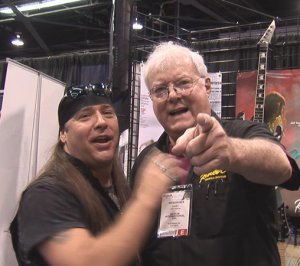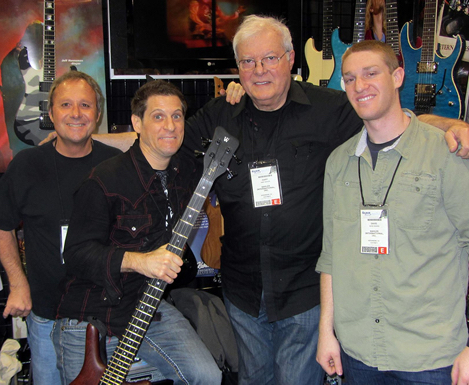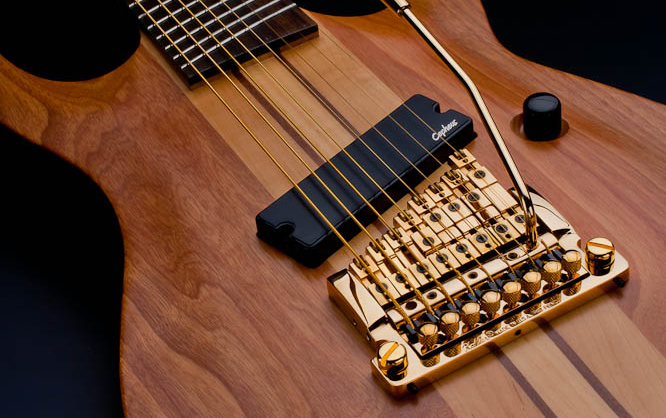Our Story
During the late 70’s, Gary Kahler of Kahler Systems International formed a company by the name of Brass Factory.
This company built guitar hardware exclusively of 360 H/H brass and his first major customer was Fender. Together with Fender they established the Brass Works line of Fender hardware that included the classic claw bridge and standard Fender bridges. Shortly thereafter, he began building brass products for Dimarzio’s guitar and bass lines as well. It isn’t until 1981 that American Precision Metal Works Inc., a division of Kahler Systems International; unveils the Kahler tremolo as we know it today. Timing could not have been better as there was a genuine surge of interest in the electric guitar. At the music trade show in 1982, we accepted over $3,500,000 in orders sending us into overdrive in production and taking us 8 months to fill the back log from the show alone.

During the 80’s, the Kahler tremolo enjoyed tremendous success. Almost all major guitar manufactures where offering models within their line carrying the Kahler tremolo and artist endorsements were astonishing. But there was a demand in the market for those who still desired a fulcrum style tremolo system, both from the OEM’s and end users.
The Journey
To fulfill this demand, Kahler introduced the Steeler, Killer and Spyder models. The business continued to flourish throughout the decade – to the extent that Kahler was producing 450 pieces a day with a staff of 42 employees. The design of the Kahler cam tremolo is unique. The cam operated design was developed from many years of mechanical engineering experience. The cam design offsets spring tension against the strings and smoothes the feel allowing an articulate and sensitive interaction with the guitar. Another critical component of the feel is the use of two (2) R2ZZ precision ball bearings in the cam, which help create the smooth feel and allow the tremolo to come back to in-tuneness.
By utilizing the ball bearings and cam design along with integrating rolling saddles, Kahler has created a device that maintains a consistent relationship between the string and saddle. This creates the critical contact point and is crucial to the instrument’s tone and harmonic value. By maintaining a consistent witness point between the string and saddle, there is no loss in either tone or harmonics.
The Kahler design allows for the string to cast forward when the bar is depressed never losing contact and to recede when returned to zero or pulled up on. Again, always maintaining contact. In contrast, if you were to depress a fulcrum bridge, you would essentially be tipping the bridge forward allowing the strings to lift up off the saddles losing the much needed critical contact point. Thus losing tone and the harmonics of a given note.Another point that is critical to a players overall tone is the amount of routing that is required in the installation of a Kahler unit. There is very minimal routing needed to install a Kahler tremolo. Nowhere near the amount needed for a fulcrum operating bridge. The excessive routing required to install a fulcrum takes away from the base of what is contributing another part of your tone, the wood. By allowing the instrument to maintain its mass in wood, you maintain your tone and have the added flexibility of a tremolo device.


Transition And REturn
Intellectual patents began to be challenged relentlessly and R&D funding was being lost to fund legal bills. During late 1990, electro plating was becoming a major source of business for American Precision Metal Works and the tremolo market began to slow.
It was at this time, the business split into two separate entities, Artistic Plating and Kahler International Inc. As the demand for tremolo systems continued to dwindle, simultaneously the demand for golf clubs began to sky rocket. Now, although the end users of golf clubs and guitar tremolos may be drastically different, the manufacturing process is very similar. Together with Scott Miller, an Industrial Engineer, Gary Kahler joined forces to create and market forged golf club heads and new innovative guitar components. From a business point of view, it was only obvious that manufacturing of golf clubs was a sensible venture and it quickly became the majority of Kahler International Inc revenue.
It is then in 2000, that Gary Kahler sells under option to Scott Miller and his investment group the business of manufacturing forged golf clubs and guitar components.By 2003, the sale of the company proved less than successful and by 2004, Gary Kahler had taken back the company. He immediately reinvented the company to exclusively focusing on the guitar hardware. 2004 and 2005 have been years of re establishing the business and laying ground work for the years to come.
From the customers point of view it may have seemed like an over night success. But as we all know, it doesn’t quite work that way. For many years before, Kahler had worked very closely with some of the biggest players in guitar manufacturing. Before the release of the tremolo, Kahler had been providing other guitar hardware components to the industry. It is through these established relationships with Grover Jackson, Bernie Ricco, Wayne Charvel, Fender and Gibson that the seeds become planted. In fact, it is Gibson who is the first major OEM to place an order ‘ they order up 500 pieces!

What sets Kahler Apart
But it is these relationships that prove to be essential to the growth soon to come. First, we knew that even to be competitive, we must provide quality and pricing. In order to achieve the pricing, we must be able to build in quantity. The tremolo unit needed to be retrofitting to any and all electric guitars on the market: previously, currently and in the future. This meant that the saddles had to be adjustable six ways; front to back to accommodate intonation, side to side to accommodate the varying string spacing between manufacturers and up and down – not only for the players preferred action but also for any fretboard radius a manufacture may be using. These last two points, side to side and up and down prove to be the most advantageous. This meant to the guitar manufacturer, big or small that they did not have to change the production and/or design of their current models. They didn’t have to build a different neck solely to use our product. The Kahler tremolo was a simple addition to any of the product lines they had to offer.
Secondly, it occurred to Gary Kahler the idea of fine tuning. Gary’s education is in music; he had performed professionally for years and also taught. All other instruments have fine tuning but not the guitar. It only made sense that if a violin, cellos, viola, percussion and horns could benefit from fine tuning, so should the guitar. Third, with a fulcrum style tremolo system, the resistance of pressure in the arm increases as the note drops in pitch. There had to be a way to take away the resistance and provide the artist with a free floating device that was sensitive to the artists playing style and technique. A cam operated devise to offset spring tension and provide a smooth, comfortable feel.


Over a period of two years, these concepts are put to the test. Through an introduction by Grover Jackson, Gary Kahler meets with Dave Storey at the San Francisco airport. Dave was not only a guitar player but one of very mechanical means. He had also sought to overcome the issues of a fulcrum style tremolo and created his own cam operating system. Together with Dave’s concepts, Kahler Systems International eventually brought the product to market and we then have what is familiar to us today as the Kahler tremolo system.
Because we were able to implement all of these characteristics into the design, we enjoyed tremendous success not only with the OEM’s but the after market business as well.
With the release of his album, The Twang Bar King in 1983 Adrian Belew’s endorsement set a lot of the Kahler success in motion. Simultaneously, we had Phil Collen of Def Leppard using our tremolos on everything and being seen on MTV all day long. Then you had Steve Vai incorporating the Kahler on his Loch Ness Green JEM making the Kahler tremolo required hardware for any guitar virtuoso. Not to mention, on the bass side, the endorsement of Billy Sheehan. These players along with Kerry King, K.K. Downing and Glenn Tipton of Judas Priest, Neal Schon and Jeff Beck really laid the ground work. All of these players were and still are very much on or at the top of their game.
There are over 2 million Kahler units out there right now and first and foremost, we want to be sure that the players receive the service and support that they deserve. That adds up to over $300,000,000 at retail value. We owe it to the players and the manufactures to be here for them.
What we are really focusing on right now is the production and marketing of the Kahler cam operated tremolo systems. The modifications have come about in offering the end user a variety of different metals to help the artist create their own, unique tone.
Please take a moment and read through our new website where you be able learn even more about the Kahler tremolo, the new models, artist users and other related information. Should you ever have any questions or comments, please feel free to contact us at your earliest convenience.